Teacher observation feedback examples. Teacher observation feedback is a crucial element in enhancing teaching practices, promoting professional development, and fostering school-wide improvement. Administrators play a pivotal role in providing constructive guidance to teachers during these observations. In this comprehensive guide, we present a wide range of teacher observation feedback examples, designed to empower educators and administrators with the tools they need to drive positive change in the classroom.
Positive Teacher Observation Feedback Examples
- Engaging Communication: Your clear and engaging communication style captivated students’ attention throughout the lesson, creating an optimal learning environment.
- Effective Lesson Planning: Your well-thought-out lesson plans seamlessly facilitated the flow of content, resulting in an enhanced learning experience for students.
- Individualized Support: Commendable efforts were made in providing individualized support to struggling students, demonstrating your commitment to their success.
- Enthusiastic Teaching: Your enthusiasm for teaching significantly contributes to a positive and inspiring learning atmosphere.
- Real-world Relevance: Incorporating current events into your lessons makes them more relatable and engaging for students, showcasing your innovative approach.
- Innovative Strategies: Your willingness to experiment with new teaching strategies is admirable and fosters continuous improvement.
- Mutual Respect: The strong sense of mutual respect observed between you and your students promotes a harmonious classroom environment conducive to learning.
- Positive Reinforcement: Your consistent use of positive reinforcement boosts students’ confidence and motivation to excel academically.
- Accountability Culture: The consistent use of self-assessment in the classroom fosters a culture of accountability among students, empowering them to take ownership of their learning journey.
- Inclusive Environment: Your dedication to creating an inclusive space where all students can thrive is commendable and contributes to a diverse and supportive classroom community.
Constructive Teacher Observation Feedback Examples
- Targeted Support: Recognizing students needing additional help during group activities, providing targeted support can address their specific needs effectively.
- Challenging High Achievers: To further challenge high-achieving students, consider creating opportunities for extension activities that cater to their advanced capabilities.
- Promoting Collaboration: Enhance learning by providing more opportunities for collaboration among students, fostering teamwork and shared understanding.
- Group Projects: Consider incorporating more group projects into your curriculum to promote peer collaboration and shared problem-solving.
- Stimulating Discussions: Integrating open-ended questions can stimulate more in-depth classroom discussions, encouraging critical thinking.
- Student Involvement: To create a student-centered classroom, involve students in setting learning goals, empowering them to take ownership of their education.
- Leveraging Technology: Explore the integration of technology tools to enhance interactive learning experiences and cater to diverse learning styles.
- Diverse Perspectives: Incorporate diverse perspectives into your curriculum to foster inclusivity and broaden students’ horizons.
- Hands-on Learning: Providing hands-on learning opportunities can enhance students’ understanding of theoretical concepts and make learning more engaging.
- Student-led Discussions: Encourage student-led discussions to develop their communication skills and promote active participation in class.
MORE SAMPLES
Positive Teacher Observation Feedback Examples
- Your effective communication style captured the attention of students throughout the lesson. Keep up the great work.
- Your lesson planning reflects careful consideration, resulting in a seamless flow of content and an improved learning experience.
- I commend your dedication to providing personalized support to students who are facing challenges.
- Your enthusiasm for teaching creates a positive and conducive learning atmosphere.
- Incorporating current events into your classes enhances their relevance. Well done.
- Your willingness to experiment with innovative teaching strategies is praiseworthy.
- I observed a notable sense of mutual respect between you and your students.
- Your use of positive reinforcement boosts students’ confidence and motivation effectively.
- You consistently implement self-assessment in the classroom, fostering a culture of accountability.
- Thank you for establishing an inclusive environment where every student can thrive.
- Your positive influence on students is highly commendable.
- I appreciate the way you promote peer collaboration, allowing students to learn from each other through group activities.
- Your commitment to your students is commendable.
- Excellent use of formative assessments to effectively gauge student understanding.
- Your performance and dedication stand out.
- I deeply admire your exceptional teaching abilities.
- Your positive impact on the school community is greatly appreciated.
- Your dedication to continuous professional development and growth is truly inspiring.
- The work you do in this school makes us proud.
- Your classroom management strategies are praiseworthy.
Constructive Teacher Observation Feedback Examples
- I noticed some students requiring extra assistance during group activities. Providing targeted support can be beneficial.
- To further challenge high-achieving students, consider creating opportunities for extension activities.
- Enhancing learning can be achieved by providing more collaboration opportunities for students.
- Incorporating more group projects can promote peer collaboration.
- Integrating open-ended questions is recommended to stimulate classroom discussions.
- To foster a more student-centered classroom, consider involving students in setting learning goals.
- Exploring the integration of technology tools can enhance interactive learning.
- Encouraging diverse perspectives in your curriculum can foster a more inclusive environment.
- Enhancing students’ comprehension of theoretical concepts can be achieved by providing more hands-on learning opportunities.
- Encouraging more student-led discussions can develop their communication skills.
- Implementing positive reinforcement when addressing problematic behavior is advisable.
- Inconsistencies in classroom management were observed. Please work on improving them.
- Ensuring clear learning objectives are communicated at the beginning of each class is essential for guiding student understanding.
- Addressing time management is necessary to ensure students complete all planned activities within the allotted time.
- Consistency in enforcing classroom rules will create a more focused learning environment.
- Providing more specific and timely feedback to students on their assignments is encouraged.
- Diversifying assessment methods can provide a more comprehensive evaluation of students’ comprehension.
- Addressing disruptions promptly is crucial to maintaining a smooth flow of instruction.
- Ensuring technology enhances learning without causing distractions is important.
- Striving to provide more structured lesson plans will enhance instructional delivery.
Sample Feedback After Teacher Observation
- Impressive incorporation of interactive activities during classes.
- Your classroom management techniques are highly commendable.
- Effective use of multimedia resources to enhance classes and accommodate various learning styles.
- Maintaining better classroom pacing is essential for ensuring all students can follow the class effectively.
- Some students faced challenges in following instructions. Providing clearer explanations or breaking down complex tasks can be helpful.
- Encouraging shy students to share their ideas through various means promotes inclusivity.
- Recognizing and acknowledging students’ efforts through positive reinforcement is motivating.
- Varying the pace of the class to maintain student interest and accommodate different learning preferences is recommended.
- Creating a nurturing atmosphere where students feel comfortable asking questions is praiseworthy.
- The integration of real-world examples effectively demonstrates the practical applications of concepts.
- To enhance student comprehension, consider providing more opportunities for guided practice.
- Encouraging more group activities can foster teamwork and peer learning.
- Addressing distractions during independent work time is important. Implementing strategies to keep students focused is advised.
- Your ability to adapt and tailor lessons based on students’ needs and responses is commendable.
- Integrating more opportunities for self-assessment can promote student ownership of learning and self-efficacy.
- Incorporating more hands-on activities can enhance students’ understanding of complex concepts.
- Providing specific feedback that helps students understand areas for improvement is beneficial.
- While your teaching of the subject matter is excellent, exploring cross-curricular connections can deepen students’ understanding of topics.
- Your use of open-ended questions encourages thoughtful responses from students.
- Setting challenging yet achievable learning goals can further motivate high-achieving students.
- Utilizing formative assessments throughout the class effectively allows for monitoring student progress.
- To promote a positive classroom culture, continue fostering a respectful learning environment.
- A well-structured lesson plan with clear objectives leads to a focused learning experience.
- The use of visual aids effectively enhances the understanding of complex concepts.
- Incorporating more key discussion strategies into your lesson plans can promote students’ intellectual curiosity.
- Effective differentiation strategies cater to students’ diverse learning needs.
- Considering ways to maintain student interest by reducing inputs is advisable.
- Some instances of unclear explanations were observed. Using straightforward language to aid understanding is recommended.
- Checking students’ comprehension levels before starting class discussions is helpful.
- Addressing potential foot-dragging during transitions between activities may improve efficiency.
Conclusion
Administrators and educators can leverage these comprehensive teacher observation feedback examples to facilitate professional growth and cultivate a culture of continuous improvement in their educational institutions. Constructive feedback, when delivered effectively, empowers teachers to excel and, in turn, drives positive outcomes in the classroom.
MORE:
Lesson Plan Template Google Docs
Effective Teacher Observation Techniques: Using Positive Comments to Improve Performance
Simple Lesson Plan Template




